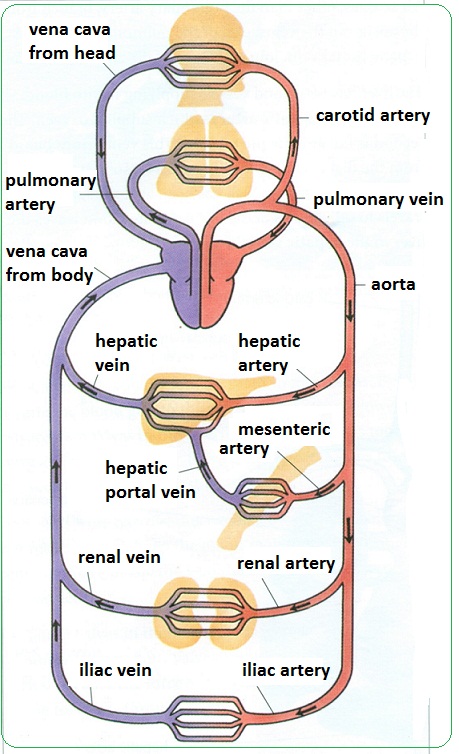Blood vessels
Blood vessels
Blood vessels are part of the circulatory system that transports blood throughout the body. There are three major types of blood vessels: the arteries, which carry the blood away from the heart, the capillaries, which enable the actual exchange of water, nutrients and chemicals between the blood and the tissues; and the veins, which carry blood from the capillaries back towards the heart.
All arteries, with the exception of the pulmonary and umbilical arteries, carry oxygenated blood, while most veins carry deoxygenated blood from the tissues back to the heart; exceptions are the pulmonary and umbilical veins, both of which carry oxygenated blood. The capillaries form the microcirculatory system, and it is at this point that nutrients, gases, water and electrolytes are exchanged between the blood and the tissue fluid. Capillaries are tiny, extremely thin‐walled vessels and act as a bridge between arteries and veins.
Structure and function of arteries and veins
The walls consist of three layers-
- The tunica interna
- The tunica media
- The tunica externa (adventia).
The tunica Interna-
The tunica interna is a thin layer (only a few cells thick) of a vein and artery. It is sometimes referred to as the intima membrane. It is this layer that gives smoothness to the lining of the vessel, enhancing blood flow. It is lined by endothelial cells and elastic tissues; however, it varies in thickness between the blood vessels-
- Arteries – most elastic tissue
- Veins – very little tissue
- Capillaries – no elastic layer.
The tunica media
The tunica media consists of elastic fibres and smooth muscle that allow for vasoconstriction, changing blood flow and pressure. The tunica media is supplied by the sympathetic branch of the autonomic nervous system. When stimulated, the walls contract, narrowing the lumen and increasing pressure within the blood vessel:
- Arteries – varies by the size of the artery
- Veins – thin layer
- Capillaries – do not have tunica media.
The tunica externa (adventia)-
The tunica externa (adventia) consists of collagen fibres and varies in thickness between the vessels. The collagen serves to anchor the blood vessel to nearby organs, giving it support and stability
- Arteries – relatively thick
- Veins – relatively thick
- Capillaries – very delicate.

Differences between arteries and veins
| Arteries | Veins |
| Transport blood away from the heart | Transport blood to the heart |
| Carry oxygenated blood, except the pulmonary and umbilical arteries |
Carry deoxygenated blood, except the pulmonary and umbilical veins |
| Have a narrow lumen | Have a wider lumen |
| Have more elastic tissue | Have less elastic tissue |
| Do not have valves | Do have valves |
| Transport blood under pressure | Transport blood under low pressure |
Capillaries
Capillaries are tiny blood vessels, approximately 5–20 µm in diameter. There are networks of capillaries in most of the organs and tissues of the body. Capillary walls are only one cell thick, which allows exchange of material between the contents of the capillary and the surrounding tissue fluid. The walls of capillaries are composed of a single layer of cells, the endothelium. This layer is so thin that molecules such as oxygen, water and lipids can pass through them by diffusion and enter the tissues. Waste products such as carbon dioxide and urea can diffuse back into the blood to be carried away for removal. Capillaries are so small that the red blood cells need to change shape in order to pass through them in single file.
